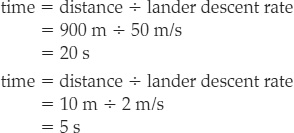Practicing Geology Exercise
How Do We Land a Spacecraft on Mars? Seven Minutes of Terror
When we send a lander to Mars, how do we decide where to land it? The riskiest part of such a mission comes when the spacecraft enters the Martian atmosphere, descends through it, and lands on the planet’s surface. This step, called Entry, Descent, and Landing, or “EDL,” takes about 7 minutes. During that time, the lander decelerates from 12,000 to 0 miles per hour, and its heat shield becomes as hot as the surface of the Sun (about 1500°C) due to friction caused by the atmosphere. A lot can go wrong here, so EDL has been called “seven minutes of terror.”
The shape and elevation of the Martian surface play key roles in lander design. The lander holds a limited amount of fuel to power its engines, so if the land surface varies too much in its elevation, the lander has to spend time (and fuel) maneuvering. Your task as the EDL team geologist is to choose a safe landing site—one that does not vary too much in elevation. At the same time, you will want to choose a site that provides interesting outcrops for the lander or rover to study. So your problem is to determine how much variation in elevation is “too much.”
To solve this problem, we need the following information: The lander’s engines start up when the radar determines that the lander is 1000 m above the Martian surface. The engines slow the lander’s descent, allowing it to descend at a rate of 50 meters per second (m/s) until it is 10 m above the ground. At that point, the lander descends at 2 m/s until touchdown. The engine’s fuel consumption rate is 5 liters per second (L/s). The fuel tank holds 150 L.
First, how long does it take for the lander to descend to the surface? Note that two rates must be used here: one for the first 990 m of descent, and the other for the last 10 m of descent.

total time = 20 s + 5 s = 25 s
Next, how much fuel is consumed during landing?

250

Given that 150 L of fuel are available, but only 125 L are used, there would be a reserve of 25 L remaining after landing. This calculation is for the “perfect” landing condition in which the total descent distance is 1000 m (see “Case 1” in the accompanying figure).
Now let’s consider what would happen if the lander drifted sideways while descending because the wind was blowing and moved over a low spot on the Martian surface (see “Case 2” in the accompanying figure). In this case, the total descent distance would be greater than 1000 m. If the low spot were too low, the lander would be at risk of depleting all its fuel reserves before it ever landed and crashing to the surface. Therefore, we need to determine how much elevation change would use up this fuel reserve.
First, we need to determine how much reserve time is provided by the 25 L of reserve fuel:

Now we can determine the additional descent distance that could be safely traveled before the fuel reserve was used up:

The solution tells us how much elevation change is “too much” to tolerate for a safe landing site: anything more than 250 m is too much. The team geologist must find a landing site where elevation varies less than 250 m, yet which also provides interesting geologic features. In practice, there is a real trade-off between geologic interest and landing site safety.
BONUS PROBLEM: Determine the maximum variation in elevation at a landing site that could be tolerated by a lander with a fuel tank volume of 200 L. How much variation could be accepted if the final descent rate were 1 m/s rather than 2 m/s?
251